John R. Fultz's Blog, page 54
May 26, 2015
Tanith Lee, 1947-2015: A Legend Passes
 “Though we come and go, and pass into the shadows, where we leave behind us stories told – on paper, on the wings of butterflies, on the wind, on the hearts of others – there we are remembered, there we work magic and great change – passing on the fire like a torch – forever and forever. Till the sky falls, and all things are flawless and need no words at all.”
“Though we come and go, and pass into the shadows, where we leave behind us stories told – on paper, on the wings of butterflies, on the wind, on the hearts of others – there we are remembered, there we work magic and great change – passing on the fire like a torch – forever and forever. Till the sky falls, and all things are flawless and need no words at all.”
–Tanith Lee


May 21, 2015
TALL EAGLE: Chapter 1
 THE TESTAMENT OF TALL EAGLE
THE TESTAMENT OF TALL EAGLE
Chapter 1: “On the Spirit Trail”
is posted now at BlackGate.com for free reading.
The book goes on sale June 8.
TALL EAGLE on Facebook
TALL EAGLE @ Ragnarok


May 10, 2015
Interview: TALL EAGLE @ RagnaBlog
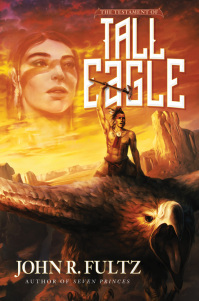
THE TESTAMENT OF TALL EAGLE will be published in June by Ragnarok Publications.
Nick Sharps interviews me in some detail about TALL EAGLE at the RagnaBlog.
THE TESTAMENT OF TALL EAGLE drops on June 8.
TALL EAGLE on Facebook
TALL EAGLE @ Ragnarok


May 7, 2015
TALL EAGLE: June 8

THE TESTAMENT OF TALL EAGLE will be published June 8 by Ragnarok Publications.
Ragnarok has announced June 8 as the release date for THE TESTAMENT OF TALL EAGLE.
The countdown begins…
A preview of Chapter 1: “On the Spirit Trail,” will soon be available for free reading at www.blackgate.com
Early in June a second preview of the novel–an excerpt from Chapter 4: “On the Blood Trail” — will appear at grimdarkmagazine.com (also free)
 On June 9 I’ll be guesting on the Far-Fetched Fables Podcast, which is presenting a special audio adaptation of my story “The Key To Your Heart Is Made Of Brass” (from YEAR’S BEST WEIRD FICTION, Vol. 1).
On June 9 I’ll be guesting on the Far-Fetched Fables Podcast, which is presenting a special audio adaptation of my story “The Key To Your Heart Is Made Of Brass” (from YEAR’S BEST WEIRD FICTION, Vol. 1).
I’m also planning an appearance on the Grim Tidings Podcast to discuss “grimdark” fantasy, TALL EAGLE, and The Books of the Shaper. I’ll post the airdate here as soon as its confirmed.
TALL EAGLE on Facebook
TALL EAGLE @ Ragnarok


April 7, 2015
ORO: Opus Primum
Italian psychedelic doom-rock geniuses UFOMAMMUT have created some of the most haunting, inspiring, and downright exhilarating sounds of the 21st Century thus far. They’ve become crucial additions to my own “Music To Write By” playlist. For their album “ORO: Opus Primum” (2012) they did something I’ve never seen before–they made a psychedelic video not for a single track, but for the ENTIRE ALBUM. When I discovered this, I had to share it. So grab your headphones and enjoy this 51-minute trip into the astral psychosphere.
BTW, the band released a brand-new album recently called “Ecate”, named after the ancient goddess of sorcery…I wonder if we’ll get another album-spanning video this time.


March 8, 2015
TALL EAGLE: 1st Advance Review
Reviewer Paul Goat Allen gives THE TESTAMENT OF TALL EAGLE 4 out of 4 stars in his advance review of the book. Some highlights:
“…seamlessly fuses together elements of
fantasy, western, horror,
and even a powerful romance.”
– and –
“An addictively readable blend of adventure fantasy à la Edgar Rice Burroughs and Michael Moorcock and classic western pulp from authors like Max Brand, TALL EAGLE takes two tried-and-true categories (adventure fantasy and western fiction) and creates something utterly delectable…”
Read the complete review right HERE.
THE TESTAMENT OF TALL EAGLE is set for release in June 2015.


March 1, 2015
Interview @ WEIRD TALES

Probably my all-time favorite WT cover, painted by the great Stephen Fabian. This issue also featured Tanith Lee’s masterpiece “Kingdoms of the Air,” which is what the cover illustrates.
Last year WEIRD TALES posted an interview with me at their website. However, some time later the site either self-destructed or was a victim of sabotage. In any case the interview has been lost along with the rest of their site. So I thought I’d run the interview here on my own page. Thanks to Doug Draa for doing the interview and to Laird Barron for linking it on his website.
WT: SEVEN SORCERERS was recently released and it concludes T-the Shaper Trilogy. Is this the last that readers will be seeing of The Shaper’s world?
JRF: Never say never. The three books definitely tell a complete story, culminating with a massive invasion. Currently there are no plans for a sequel series, however I do have an idea for a return to this world a hundred years later. Some of the characters would still be alive—giants are very long-lived and sorcerers may prolong their existence with magic—but when and if I return I’ll probably focus on the OTHER side of the world—the side we didn’t get to see in much detail in this series. I never wanted to be trapped or pigeonholed into a never-ending series. I’m anxious to spread my figurative wings and try some new things. I have a completely different series in the works right now, and I’m working on a project that’s also entirely different. Like most writers I want to stretch myself and conquer new ground, but I also have a soft spot for The Shaper Trilogy. So I might return to the Shaper’s world, but not right away.
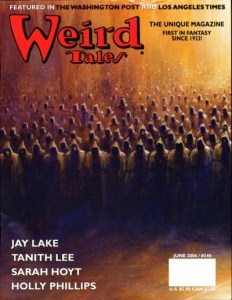
My first pro sale, “The Persecution of Artifice the Quill” appeared in WT #340, with a cover by Les Edwards that evokes the faceless Vizarchs in that story.
WT: Having read your articles for BLACK GATE, your own blog, and the afterword to SEVEN PRINCES it is obvious that you have a deep love for vintage genre fiction. Do you feel that these older works deserve more attention from younger readers than they might be receiving?
JRF: Sometimes, yes. This is an issue no matter what creative field you’re in: In music people often ignore the originals in favor of third-generation imitations. It’s the same with film and comics, not just fiction. I think any self-respecting fantasy fan should do some research (it’s so easy in the Age of the Internet) and find out who came first, who originated the tropes of our genre, and who set the wheels of our genre in motion. There is a lot to love in the history of pretty much any genre. I understand that some people are only interested in what’s “new” and some don’t want to read stories or books written in what are considered “outdated styles.” But that argument holds no water with me. Certainly the works of Shakespeare and Poe are written in “outdated styles” compared to modern writers like Martin and King—yet both authors have created timeless work. If someone doesn’t read Lord Dunsany, for example, because it’s “too old,” that person is missing a lot of great stories. The same goes for Tolkien: I grew up with some friends who preferred more modern readers imitating Tolkien because they didn’t like Tolkien’s “outdated style.” I’ve always thought it was silly, too, when people refuse to watch black-and-white movies simply because they’re not in color. Those people are missing some of the best films ever made, and the same goes for readers who don’t read Shakespeare, Poe, Dunsany, Tolkien, and other old-school writers. Yet it helps to remind myself that the experience of all art is subjective. People should be free to like what they like. Personally, I try hard to keep a balance in reading/re-reading old favorites and new works, although I admit I’m drawn more to older books. I’ve always loved exploring used bookstores, and I can always find a treasure or two in them.
 WT: Do you think that these older works contain a special something that many contemporary stories and novels are lacking? Or do you think that such laments like the one I just expressed is simply nostalgia for the stories that introduced many reader s to genre fiction? (Asimov did once say that “The Golden Age is twelve.”)
WT: Do you think that these older works contain a special something that many contemporary stories and novels are lacking? Or do you think that such laments like the one I just expressed is simply nostalgia for the stories that introduced many reader s to genre fiction? (Asimov did once say that “The Golden Age is twelve.”)
JRF: Well, Asimov did have a point: Some of the books read in that “golden age” of around 12 years old (like the movies you see at that age) can really stick with you for life. It’s a very impressionable age and books/movies/comics often “imprint” themselves on young minds. For example, one of my favorite films is BENEATH THE PLANET OF THE APES. My mind knows that the first movie (PLANET OF THE APES) is a better film, but I saw BENEATH when I was like six years old, and re-watched it for years on television whenever it was on (these were the pre-VCR days). That movie imprinted itself upon me, and I will always love it. LORD OF THE RINGS imprinted itself upon me in the same way, although it happened at an even younger age. In my teens Moorcock’s ELRIC stories imprinted themselves. In my early 20s its was Tanith Lee’s FLAT EARTH series and the story-cycles of Darrell Schweitzer. But I also remember discovering Lord Dunsany at this time, reaching all the way back to 1911 to read A DREAMER’S TALES. So I think this imprinting happens early in life for most people, but for some of us (artists?) we continue to be imprinted by things we discover throughout our whole life. Perhaps this separates writers and creative types from “normal” people, who generally are too busy with living Real Life to keep being imprinted by works of art. Or perhaps that’s too simplistic and not accurate. Your question seems to be asking “Is it all just nostalgia?” and I have to say definitely no. There is a lot more to it, and here’s why: A great work of art is a great work of art. Let’s go back to Shakespeare again. His works are 500 years out of date, yet they still represent the best and worst of humanity, as well as some of the greatest stories every told by man. Timeless is the word. Great art is timeless. By its very nature Art defies time and space. Nowhere is this more true than in the realm of storytelling, an ancient art that has been with us since we were cave-dwellers.

FUNGI #21, the magazine’s 30th anniversary issue.
WT: I finally had the chance to read “The Key to Your Heart Is Made of Brass” and “Flesh of the City, Bones of the World” in the 30th Anniversary Issue of FUNGI. I found the world you’ve created therein (The Urbille) to be one of the most original settings that I’ve read in ages. Both stories were entertaining and extremely moving. Did you have any trouble placing them?
JRF: Ha! Yes, these stories were too damn weird. First “Key” (then later “Flesh”, which is its sequel) was rejected nine times by nine different editors. “Key” made the editorial rounds for four years before it found a home. One editor kept “Key” on her desk for a solid year before rejecting it, then another editor kept it for another year before declining to publish it. It was kind of surreal: Everybody had good things to say about the story, but for whatever reason they didn’t want to publish it. A third editor didn’t like the ending of “Key”, while a fourth editor thought I was trying to make some silly misogynist statement. However, I got so many positive comments about “Key” that I wrote a sequel to it—even though I hadn’t sold it yet—and then I sent the sequel (“Flesh”) on the same editorial round-trip journey. Both stories were rejected exactly nine times before Pierre Comtois asked to run them in the 30th Anniversary issue of FUNGI. This marked the first time I ever had two stories running in the same issue of any magazine. Now that the amazing Laird Barron has recognized “Key” and included it in his YEAR’S BEST WEIRD FICTION, Vol. 1, I feel entirely vindicated. I may write more stories in the universe of the Urbille. Possibly even a novel. A very weird novel.
WT: What would you be creating if you were to write purely for yourself and sales be damned. Or are you already doing this?
 JRF: That’s exactly what I did when I wrote SEVEN PRINCES. I didn’t have an agent or a book deal. I had only the raw determination to “graduate” from short stories (which I’d been selling semi-regularly for a few years) and comics to prose novels. I started writing the novel on blind faith, with no constraints but my own imagination. I decided to write a “Big Fantasy Novel” and told myself “I will find an agent” and “I will get it published somewhere…somehow.” The first draft of the novel I entirely scrapped, came back the next year and wrote a new novel in the same world but set 20 years into the future. I usually have summers off from teaching, so that’s my main “writing season.” I started SEVEN PRINCES thinking “I will not rush this. It will take as long as it takes, and it will be everything I’ve always want to see in an Epic Fantasy.) I wrote exactly what I wanted to write, and I joined a local writers’ group to get priceless feedback on the early chapters. It took me three years to find an agent, and one year after I found him, he found me a deal with Orbit. The great thing about that deal was that I had carte blanche to write the second book (SEVEN KINGS) and third book (SEVEN SORCERERS) with very little editorial intervention up-front. However, I did get some good editorial feedback after each novel was completed, mostly from the terrific Tom Bouman (who is no longer with Orbit). Although I’m writing ostensibly for the “fantasy market” I don’t think about it in that way. I still write first and foremost for myself. If I can’t please me, how could I ever hope to please anyone else?
JRF: That’s exactly what I did when I wrote SEVEN PRINCES. I didn’t have an agent or a book deal. I had only the raw determination to “graduate” from short stories (which I’d been selling semi-regularly for a few years) and comics to prose novels. I started writing the novel on blind faith, with no constraints but my own imagination. I decided to write a “Big Fantasy Novel” and told myself “I will find an agent” and “I will get it published somewhere…somehow.” The first draft of the novel I entirely scrapped, came back the next year and wrote a new novel in the same world but set 20 years into the future. I usually have summers off from teaching, so that’s my main “writing season.” I started SEVEN PRINCES thinking “I will not rush this. It will take as long as it takes, and it will be everything I’ve always want to see in an Epic Fantasy.) I wrote exactly what I wanted to write, and I joined a local writers’ group to get priceless feedback on the early chapters. It took me three years to find an agent, and one year after I found him, he found me a deal with Orbit. The great thing about that deal was that I had carte blanche to write the second book (SEVEN KINGS) and third book (SEVEN SORCERERS) with very little editorial intervention up-front. However, I did get some good editorial feedback after each novel was completed, mostly from the terrific Tom Bouman (who is no longer with Orbit). Although I’m writing ostensibly for the “fantasy market” I don’t think about it in that way. I still write first and foremost for myself. If I can’t please me, how could I ever hope to please anyone else?
WT: If you could spend an evening over beers with any two writers in the world, one living and one dead, who would they be and why?

DEATH’S MASTER was the novel that made me an instant Tanith Lee devotee.
JRF: For my living writer I’d have to pick Tanith Lee. Her work is immensely inspiring. She is a true Storyteller of the highest calibre, not to mention a Fantasy Grandmaster. I’ve always wanted to meet her, but I’m sure I’d be tongue-tied and starstruck. But if I could get over that initial shock (perhaps a beer or two would do it) I’d love to discuss writing, storytelling, history, and the state of humanity with Tanith well into the wee hours of the night. For a non-living writer, I’d have to pick Clark Ashton Smith. Last summer I drove through Auburn, California, for the first time. It was late at night and it was a surreal experience—the tiny town where Smith lived and wrote all of his life. I wanted to find the place where his cabin used to sit and hold a vigil or meditate there. I’m hoping to make it back there when I have a bit more time to commune with his spirit. Smith is my favorite of the “big three” WEIRD TALES writers, and his dark fantasies have inspired me since I was a kid excavating his work from second-hand bookstores.
WT: Here is a list of names: Abraham Merrit, Clark Ashton Smith, Robert E. Howard, Darrell Schweitzer. I think that your writing includes you as the newest addition to this list. What is your opinion of that?
 JRF: That is a very humbling compliment, so thank you very much. Smith and Howard are definitely among my strongest influences, as is Darrell Schweitzer. Darrell has given me great advice on writing, storytelling, and publishing for going on two decades now. I started sending stories into WEIRD TALES when I was in college—the late 80s. I’ve talked in many interviews about the many rejections I got from Darrell and the advice he gave me in those letters. Eventually, after 15 years of learning my craft and submitting to WT, he bought my first story “The Persecution of Artifice the Quill” for WEIRD TALES #340. [This story now appears in my collection THE REVELATIONS OF ZANG, where it begins a 12-story cycle.] A year or two later I finally got to meet with Darrell in person at the World Fantasy Convention, and have enjoyed the pleasure of his company a few more times since. But it’s not just the fact that Darrell has been a mentor—he is also one of the greatest living fantasy writers on the planet. His work speaks to me in a metaphysical way that feels like true sorcery. His writing is magic, and in a perfect world his many story collections would be far more widely appreciated. This often happens to true genius—it is misunderstood and unrecognized by all but a certain segment of society. It’s not often that one can gain the friendship of an author whose work has been so important to you. So I consider myself lucky to have earned the friendship of Darrell Schweitzer. I dedicated my first novel SEVEN PRINCES to him. (I have to admit that I haven’t read much by A. Merrit, though I am familiar with him.)
JRF: That is a very humbling compliment, so thank you very much. Smith and Howard are definitely among my strongest influences, as is Darrell Schweitzer. Darrell has given me great advice on writing, storytelling, and publishing for going on two decades now. I started sending stories into WEIRD TALES when I was in college—the late 80s. I’ve talked in many interviews about the many rejections I got from Darrell and the advice he gave me in those letters. Eventually, after 15 years of learning my craft and submitting to WT, he bought my first story “The Persecution of Artifice the Quill” for WEIRD TALES #340. [This story now appears in my collection THE REVELATIONS OF ZANG, where it begins a 12-story cycle.] A year or two later I finally got to meet with Darrell in person at the World Fantasy Convention, and have enjoyed the pleasure of his company a few more times since. But it’s not just the fact that Darrell has been a mentor—he is also one of the greatest living fantasy writers on the planet. His work speaks to me in a metaphysical way that feels like true sorcery. His writing is magic, and in a perfect world his many story collections would be far more widely appreciated. This often happens to true genius—it is misunderstood and unrecognized by all but a certain segment of society. It’s not often that one can gain the friendship of an author whose work has been so important to you. So I consider myself lucky to have earned the friendship of Darrell Schweitzer. I dedicated my first novel SEVEN PRINCES to him. (I have to admit that I haven’t read much by A. Merrit, though I am familiar with him.)

THE TESTAMENT OF TALL EAGLE will be published in June by Ragnarok Publications.
WT: Do your students read your stories? And what has been their reaction?
JRF: Most kids these days don’t read short stories—or at least they don’t seek them out. They’d rather read novels. Many of my students have read SEVEN PRINCES, and some have read the entire Shaper Trilogy. I teach at the high school level, and the students find it fascinating that I’m a “real author.” Of course the first two questions they ask are usually “Are you famous?” and “Are you rich?” And while I am neither, they still appreciate that they’re being taught to write (and read) by an actual writer who knows what he’s talking about. I also am sure to donate copies of my books to my school library so students can read them even if they can’t afford to buy them. Libraries are still so important, even in this age of digital entertainment. A book will never run out of batteries.
———————————————–


February 18, 2015
More TALL EAGLE Art

Cover art by Alex Raspad.
The talented Oksana Dmitrienko did three superb interior illustrations for THE TESTAMENT OF TALL EAGLE, and here they are for your viewing pleasure. Each image illustrates a key scene from the book, and I couldn’t be happier with the results. Oksana’s work has a real classic illustration feel to it. These images would have been right at home in a pulp magazine from the early 20th Century. (Click images to enlarge.)
Big thanks to Ragnarok Publications for going the extra mile on the artwork for TALL EAGLE. This is going to be one gorgeous volume inside and out.
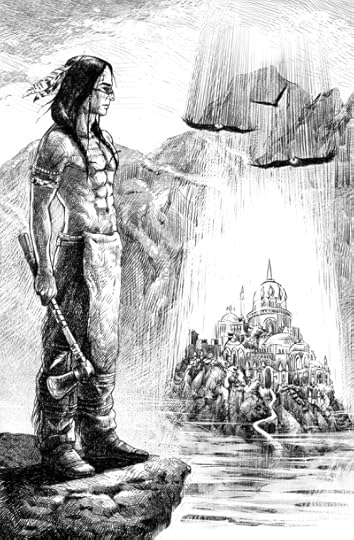
“A second mountain sat atop the first. Yet the second mountain was made of glowing gold, beaded with shimmering crystals set in weird designs. The second mountain had been carved into slim, pointed spires like tremendous teepees of gold.”
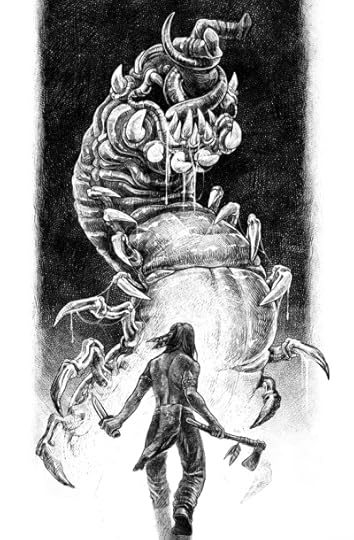
“Like a vast centipede it crawled on dozens of segmented, pointed legs depending from its slug-like body. It was longer than eight horses standing nose-to-flank in a row. A great, stinking worm. It had crawled into our camp, and grabbed Bear Killer in its mouth.”
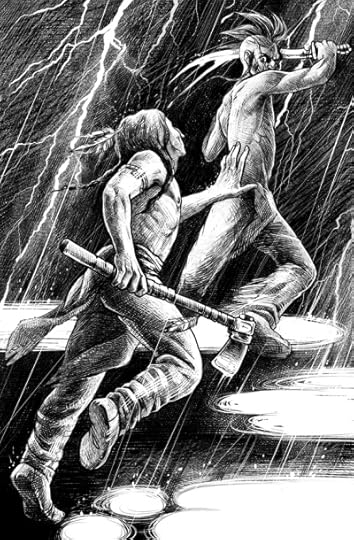
“Some grave battle wound had deadened the eye and torn away part of the face. A gleam of white bone showed below the left temple, surrounded by a furrow of pink, raw flesh. Despite this disfigurement, despite the bone-white eye and the mouth twisted into a grimace of hatred, I knew that face better than any living man’s.”
THE TESTAMENT OF TALL EAGLE will be flying your way in June.


February 9, 2015
TALL EAGLE: The Cover!
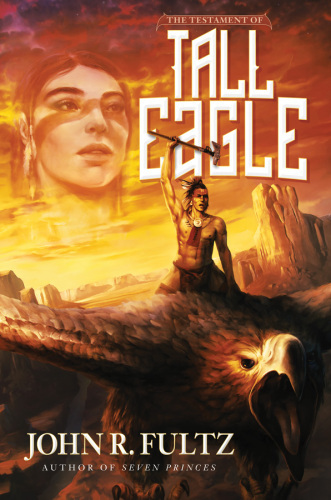
Click for larger view
Feast your eyes, my friends…
It’s the final cover design for THE TESTAMENT OF TALL EAGLE, featuring the fantastic painted artwork of Alex Raspad and logo design by the talented Shawn King. It’s truly a thing of beauty.
Ragnarok Publications will release the novel in both print and electronic formats in late June.
Here’s my official spoiler-free overview of the novel, which I’ve described as a Tribal Fantasy:
A young warrior’s vision-quest unveils an alien city full of magic and mystery. As a tribal rift threatens to destroy Tall Eagle’s people, night-crawling devils stalk and devour them, so he seeks the wisdom of the high-flying Myktu. These fantastic beings offer him hope, a chance for rebirth and prosperity, as two separate realities converge. Yet first Tall Eagle must find White Fawn–the girl he was born to love–and steal her back from the camp of his savage enemies. His best friend has become his deadliest rival, and now he must outwit an invading army of conquerors to lead his people into the Land Beyond the Sun.
THE TESTAMENT OF TALL EAGLE is the epic saga of The People, as told in the words of their greatest hero.
Here’s a previous post where I talked about some of the major inspirations for the novel.
Finally, a look at Raspad’s cover art free of text and logo. Love that sky!

Click for larger view


January 16, 2015
That Is Not Dead…
 THAT IS NOT DEAD, the historical Cthulhu Mythos anthology I mentioned here awhile back, is now slated for a February release from PS Publishing.
THAT IS NOT DEAD, the historical Cthulhu Mythos anthology I mentioned here awhile back, is now slated for a February release from PS Publishing.
It includes my story “Anno Domini Azathoth”, which is set in the 1781 Arizona Territory.
Oh, the horror….the horror…
I posted an updated table of contents with full cover art at BlackGate.com.
Pre-order THAT IS NOT DEAD here.





